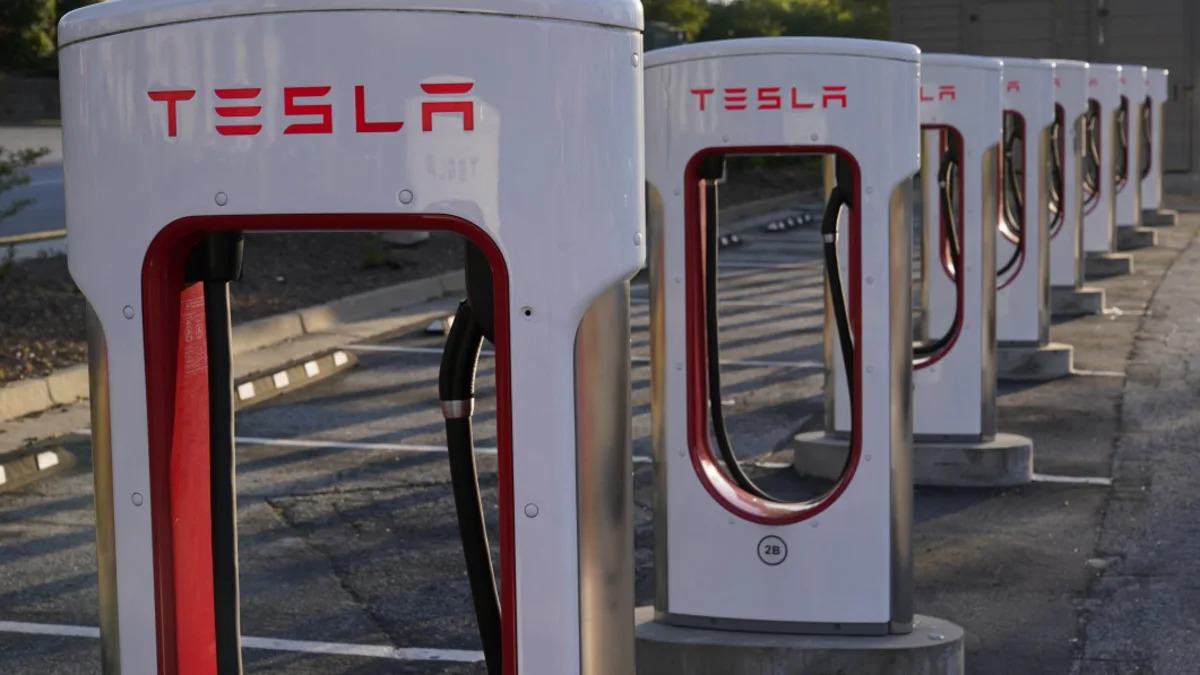Electric vehicles offer longer range estimates and faster charging times than anyone thought possible just a few years ago, but the charging network in the United States needs some work. The Biden administration recently announced new standards and outlined its progress toward building a made-in-America charging network. As part of the push, the administration has convinced Tesla to open its Supercharger network to owners of other EV brands.
The administration wants to build a network of 500,000 chargers along highways and move at least half of new vehicle sales to electrics by 2030. Tesla was already working toward opening its charging network to other EV brands, but the process in the U.S. will be expensive and time-consuming. The automaker uses a proprietary charging plug here, which requires an adapter to work on other brands of EVs. Any effort to open the Supercharger network to outside brands would involve a costly retrofit or equipment update with the adapter, but the push from the federal government is likely the spark Tesla needed to get moving.
As part of the deal, Tesla will open a portion of its Supercharger and Destination Charger network to other brands, which the government said will add at least 7,500 chargers to the system by the end of 2024, 3,500 of which are Superchargers. The automaker will also more than double its Supercharger network with equipment made in Buffalo, New York. It's worth noting that the language in the deal is likely referring to individual chargers instead of charging sites. Tesla has 1,664 Supercharger sites in the U.S. right now, so it's unlikely we'll see a doubling of physical locations by the end of 2024.
Tesla chargers are called different things depending on charging speeds. Destination Chargers can add up to 44 miles of range per hour to some Tesla models, which is between Level 2 and Level 3 charging speeds. Superchargers can charge at 250 kWh, which isn't the fastest speed available today, yet that's at or beyond the charging speed of many EVs. Destination Chargers tend to be located at hotels, restaurants, parking garages, and other end-point locations, while Superchargers tend to be located together in dedicated charging stations.
Beyond the charger, speeds depend heavily on the EV model and its onboard charging configuration. Newer EVs, such as the Kia EV6, offer 800-volt architecture, which means they can accept a much faster charge than others. The speed with which a non-Tesla can charge at a Tesla location won't be any faster than at other chargers if the vehicle can't take advantage of the available power.
We don’t know how much money will be involved in this effort, but Tesla opening its network opens the door for it to obtain funding under the $7.5 billion federal electrification program. It’s also likely that the automaker felt competitive pressure. Keeping its charging network exclusive could mean letting its rivals run away with federal funding and also charging revenue streams down the road.
Though not as buzzworthy, the White House announced several other new and upcoming EV charging projects. Hertz and BP are partnering to add charging stations to car rental sites in major cities. The rental company also plans to electrify a quarter of its fleet by the end of next year. GM, EVgo, and Pilot are partnering to build 2,000 350kW fast chargers at travel center locations on highways. In total, major automakers and related companies will initiate almost a dozen charger projects in the next few years.
Under the administration's plan, all EV drivers will be able to access Tesla stations using the Tesla app or website, officials said. Also, Tesla plans to triple its nationwide network of Superchargers over the next few years, the White House said.
The developments come after top White House aides met with Tesla CEO Elon Musk in Washington last month. Biden did not attend the meeting, which centered on the EV industry and the broader goal of electrification of the U.S. economy, the White House said.
A week later, the Treasury Department said it is making more electric vehicles — including SUVs made by Tesla, Ford and General Motors — eligible for tax credits of up to $7,500 under new vehicle classification definitions. The revised standards follow lobbying by Tesla and other automakers to change vehicle definitions to allow higher-priced EVs to qualify for a maximum tax credit.
Tesla raised prices on its Model Y SUV within hours of the Treasury announcement.
Sam Abuelsamid, principal analyst for Guidehouse Insight, said the agreement to open up Tesla chargers to non-Tesla EVs "is potentially a very big deal.''
Includes material from AP.
The plan "should be a big help to non-Tesla EV drivers if they can use the Tesla network and if the network remains as reliable as it is today,'' he said.
While the White House said the Tesla network should be available through use of a company app or website, an adaptor — or even a new charger design — will likely be required for non-Tesla EVs, Abuelsamid said.
Even so, a question remains, he added: "Once they open it up, will (the Tesla network) still be reliable?''


Sign in to post
Please sign in to leave a comment.
Continue